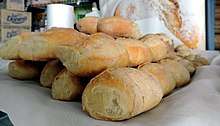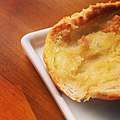Marraqueta
Marraqueta, French bread, or Portuguese roll is a crispy bread roll made with wheat flour, salt, water and yeast. This wheat bread has a crunchy texture,[1] and is very popular in South America (Chile, Brazil, the Andean region of Bolivia and Peru but can also be found in Argentina and Uruguay), and also Portugal, Mallorca, Hong Kong and Macau.
 | |
| Alternative names |
|
|---|---|
| Type | Wheat bread roll |
| Place of origin | |
| Main ingredients | Wheat flour, salt, water, leavening agent |
| 267 kcal (1118 kJ) | |
Names
- Argentina: marraqueta, pan felipe (Felipe bread)
- Bolivia: pan de batalla (staple bread)
- Brazil: pão francês (French bread), pão cacetinho, cacetinho, pão de sal (salt bread), pão de trigo (wheat bread), pão de água (water bread), aguado, careca, jacó
- Chile: marraqueta, pan batido (whipped bread), pan francés
- Hong Kong & Macau: zyu1 zai2 baau1 (豬仔包, piggy bun)
- Mallorca: llonguet, panet francès (French bread roll)
- Paraguay: pan felipe
- Peru: marraqueta, pan francés
- Portugal: paposseco, carcaça
- Uruguay: pan marsellés (Marseille bread)
Regional varieties
Bolivia
In Bolivia, the bread is called pan de batalla (battle bread). The recipe arrived in La Paz in 1908 in the hands of the Greek immigrant Michel Jorge Callispieris, from Chios island.[2] Bread in both locations share indeed the same characteristics: crunchiness and slightly salty flavor.
The Bolivian marraqueta is a 60-75 g bread, sold per unit and consumed mostly in the metropolitan area of La Paz and El Alto. It is prepared in common ovens between midnight and dawn to be sold fresh and crunchy by vendors in the morning.
The marraqueta of La Paz was declared cultural patrimony in 2006.
Brazil
In Brazil, the bread is called pão francês (French bread). It is used to make pão na chapa.
Chile
In Chile, marraqueta is also called pan batido (beaten bread) or pan francés (French bread) depending on the region. The Chilean marraqueta is, strictly speaking, a se-tenant pair of small rolls, baked with another pair attached, comprising four rolls in total; some confusion can be caused when ordering one marraqueta, as this may be interpreted as either two or four rolls.
Chiliean marraqueta bread can be divided into four pieces with the hands. It does not contain fat and the proofing process takes longer than other breads. The unusual form of the four buns allows it to be divided very easily.
Many historians agree that the marraqueta originated in Valparaíso, Chile, in the late 19th and early 20th centuries, when major Chilean ports such as Valparaíso and Talcahuano received thousands of European immigrants. The story goes the bread was invented by two French baker brothers in Valparaíso whose last name was Teran-Marraquett, and the bread went on to become very popular among Chileans in a very short time.[3] This story would explain both the marraqueta and pan francés names. In Valparaíso itself, somewhat confusingly, marraqueta means the four small rolls while half of this is called pan batido, the use of which is a shibboleth of the Port of Valparaíso (but is ignored by national supermarket chains). There is no clear agreement on what is considered one unit of marraqueta and while some bakers claim is the four pieces of bread, some others claim that a unit is only half (so they say that the four pieces are two marraquetas).
An alternative theory of the bread’s origin was proposed by French naturalist and botanist Claude Gay, who suggested that marraqueta was first eaten in Chile in the 18th century.[4]
Currently marraqueta is the most widely consumed bread in Chile and is used as toast,[5] in sandwiches and as a binder for certain recipes such as pastel de carne (meatloaf). It is widely considered the quintessential Chilean staple food.[6]
Hong Kong and Macau
Piggy bun is a type of pastry. It is a version of the Portuguese roll brought by colonizers[7]. It is the common bread in Brazil. It is found in Hong Kong bakeries and Cha chaan teng. In Hong Kong, it is often served cut in two with butter and condensed milk.[8] In Macau, it is used to make Pork chop bun.
Gallery
 Llonguet (Mallorcan-style bread)
Llonguet (Mallorcan-style bread) Marraqueta chilena (Chilean-style marraqueta)
Marraqueta chilena (Chilean-style marraqueta) Marraqueta paceña (La Paz-style marraqueta)
Marraqueta paceña (La Paz-style marraqueta) Marraqueta tacneña (Tacna-style marraqueta)
Marraqueta tacneña (Tacna-style marraqueta) Pan francés peruano (Peruvian-style French bread)
Pan francés peruano (Peruvian-style French bread) Pão francês (Brazilian-style French bread)
Pão francês (Brazilian-style French bread)- Zyu zai baau (Hong Kong-style piggy bun)
 Pão na chapa
Pão na chapa
See also
- Baguette
- Bánh mì
- Hoagie roll
- Pandesal
- Pistolet

References
- "Panes del Mundo. Tradicional Marraqueta". Magazine del Pan. Retrieved 2007. Check date values in:
|accessdate=(help) - "Archived copy". Archived from the original on 2017-06-15. Retrieved July 2016. Check date values in:
|accessdate=(help)CS1 maint: archived copy as title (link) - "Panes del Mundo. Tradicional Marraqueta". Venezuela: Magazine del Pan. 2005. Retrieved 2007. Check date values in:
|accessdate=(help) - Gay, Claudio (1865). Historia física y política de Chile según documentos adquiridos en esta república durante doce años de residencia en ella y publicada bajo los auspicios del supremo gobierno. p. 57.
En Chile hay varias clases (de pan) cuyas principales son el pan francés que es el común de la Europa, el pan inglés de forma redonda y un poco menos cocido que el anterior, el chileno sazonado con grasa y generalmente usado en las provincias, la talera que se da a los peones y a los mineros y amasada con la harina en hoja, y enfin la tortilla preparada como al tiempo de Abraham y como la preparan todavía los Árabes y otros pueblos de la África, es decir sin levadura y cocido bajo las cenizas poco antes de la comida.
- Once: A guide to Chile’s oddly-named evening snack www.thisischile.cl Monday, February 06, 2012 retrieved October 08, 2013
- Panes del Mundo - Tradicional Marraqueta www.magazinedelpan.com June 06, 2005, retrieved July 29, 2013.
- https://www.tasteatlas.com/piggy-bun
- "香港茶餐廳10款經典飲食(10)(Chinese)". 香港成報. 2013-07-09. Retrieved 2013-07-12.